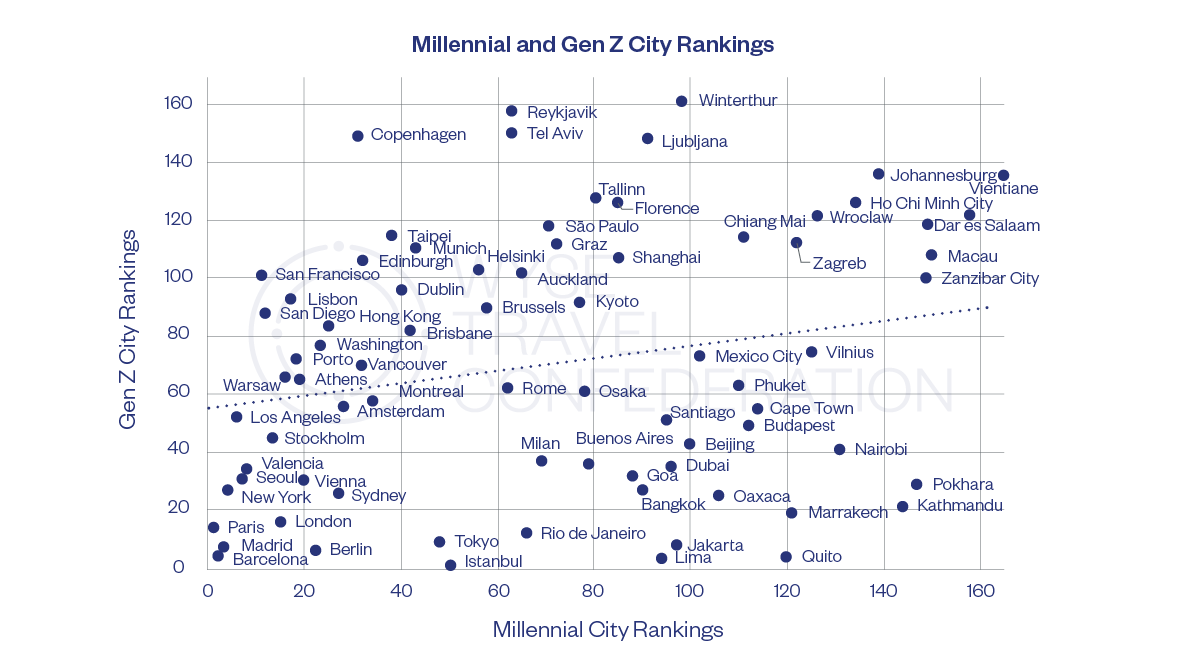There is a lot of attention given to the destination choices of young travellers, because they constitute a lucrative market for many places around the world. Cities in particular have become more interested in the youth market, particularly as dedicated youth travel accommodation has expanded in recent years. Gen Z travellers in particular are likely to head for cities, with WYSE Travel Confederation’s New Horizons data showing that almost 80% of their trips are taken to large or small cities. The challenge in such a dynamic market, of course, is predicting which cities will be the next big youth travel destinations.
We were therefore interested to see The Generational Travel Index produced by Holidu. This analyses the attractiveness of cities around the world for different generations of tourists, based on the attributed of the destination.
For Millennials an index was developed based on the
- Number of Instagram hashtags
- National dishes in the ‘100 best rated dishes’
- Family friendliness (out of a score of 5)
This is a weighted index, with Family friendliness being judged the most important attribute on the basis that most Millennials have kids. For Generation Z, the index comprises:
- Number of TikTok hashtag views
- Price of an average meal and pint of beer
- Number of UNESCO World Heritage Sites
For social media obsessed Generation Z, not surprisingly, the number of TikTok views is weighted most heavily.
These indexes are based on the destination attributes, as a surrogate measure of destination attractiveness. The basic logic is that more TikTok views will indicate greater attractiveness for Generation Z, and more family friendliness will make a place more attractive for Millennials. Based on these indices, Holidu found the top cities to be:
Millennials
- Paris, France
- Barcelona, Spain
- Madrid, Spain
- New York, New York, United States
- Miami, Florida, United States
Generation Z
- Istanbul , Turkey
- Mumbai, India
- Lima, Peru
- Quito, Ecuador
- Barcelona, Spain
We were intrigued to know how these supply-based popularity indices measured up to the demand-based data provided by WYSE Travel Confederation’s New Horizons IV survey from 2017. A first step was to examine the Holidu data on city attractiveness to see what patterns we could find. A simple scatterplot of the Millennial vs Generation Z indices for each city shows a very wide spread of data plots, with a weak positive relationship between the groups.

Cities in the bottom left-hand corner tend to be ranked relatively high by both Millennials and Generation Z, such as Barcelona, Paris and Madrid. Cities in the top right corner are ranked low by both groups, including cities such as Vientiane, Muscat and Phnom Penh. Cities in the top left-hand corner, such as San Francisco, Lisbon and Copenhagen, are ranked higher by Millennials, whereas in the bottom right we find La Paz, Kathmandu and Marrakech, which are more attractive for Generation Z. Given that Generation Z is fast replacing Millennials in the youth travel market, this should mean a shift away from cities in the top left towards cities in the bottom right of the graph.
This is always assuming, of course, that the indices used are a good measure of (future) demand. We decided to test this by comparing the Holidu supply-based rankings with the scores given by consumers to cities in WYSE Travel Confederation’s New Horizons IV survey.
We examined the relationships between the two data sets through correlations and regression analysis. We compared the cities that were included both in New Horizons and the Holidu study. We found that although there was a relatively strong correlation between Holidu’s Millennial city index and the New Horizons data, there was no significant correlation with the Generation Z scores from New Horizons. We decided to dig a bit deeper. Using regression analysis we found that of the three variables used to construct the Holidu Millennial Index, only national dishes and family friendliness had a significant impact, while Instagram posts had no effect. For Generation Z, only one of the variables, namely the cost of a beer and a meal, were significant. Perhaps surprisingly, for both groups, the social media element, whether Instagram or TikTok, had no significant effect on the rankings. It seems that the Holidu rankings are dependent on a very small number of variables, which probably do not accurately reflect the youth traveller experience of the destination. Arguably, demand-side measures, such as the New Horizons survey, will do a better job of capturing the attractiveness of cities for youth travellers.
Of course there are a number of reasons why the results of the two studies differ. One is that the last New Horizons study was conducted in 2017, and things may well have changed since the pandemic. Although whether Generation Z has suddenly become more attracted to UNESCO World Heritage Sites is debateable. Another possibility is that the emergence of ‘FOMO’ as a driver of youth travel means that people are increasingly seeking out places that have NOT been exposed on TikTok or Instagram by their friends. Or it might just be that demand-side and supply-side measures of youth travel demand are not comparable.
Interesting questions that we will be able to address with the new insights being generated by the New Horizons 5 Survey, which is currently collecting new data right now. Join us at the World Youth and Student Travel Conference (WYSTC) in Lisbon, 12-15 September 2023 to hear the first findings from the study.
 |
Author Prof. Greg Richards, Professor of Placemaking and Events Breda University of Applied Sciences |
